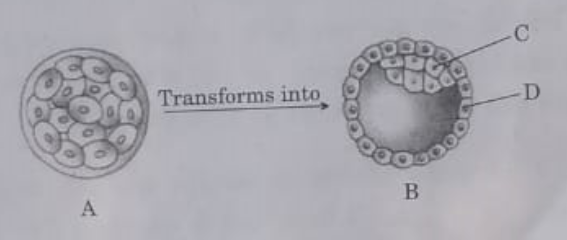In embryonic stage, cells are
Collenchymatous
Sclerenchymatous
Meristematic
Parenchymatous
The correct Answer is:C
Step-by-Step Solution:
1. Understanding Embryonic Stage: The embryonic stage of a plant refers to the early development phase after fertilization, where the plant begins to grow from a zygote into a seedling.
2. Cell Types in Plants: In plants, there are various types of cells, including meristematic, parenchymatous, collenchymatous, and sclerenchymatous cells. Each type has specific functions and locations within the plant.
3. Defining Meristematic Cells: Meristematic cells are undifferentiated cells that have the potential to divide and differentiate into various types of specialized cells. They are responsible for the growth of the plant.
4. Role of Meristematic Cells in Embryonic Development: During the embryonic stage, the cells are primarily meristematic. These cells are crucial as they give rise to primary meristems, which are involved in the formation of various organs of the plant.
5. Conclusion: Therefore, in the embryonic stage, the cells are identified as meristematic cells. This is the correct answer to the question.
Final Answer:
In the embryonic stage, cells are meristematic.
---
In the embryonic stage, cells are meristematic.
Similar Questions
In which of the following embryonic stages does the implantation take place ?
View SolutionType of neurons which comprise of one axon only and are found usually in embryonic stage are termed
View SolutionIn embryonic stage erythrocytes develop from
View SolutionFind out the correct sequence of haemopoietic tissues from early embryonic stage, after birth and an adult stages is:
View SolutionName the law that states 'Embryonic Development of an animal repeats the embryonic stages of ancestors?
View SolutionIn amniocentesis, the embryonic cells are obtained from
View SolutionAll chordates have
(a) Notochord in adult stage
(b) Solid nerve cord during embryonic stage
(c) Triploblastic nature
(d) Dorsal heartView SolutionStudy the given diagram: A is an embryonic stage that gets transformed into B, which in turn gets implanted in the endometrium in human females.

(a) Identify A, B and its parts C and D.
(b) Stage the fate of C and D in the course of embryonic development in humans.View Solution[A]: 'Ontogeny recapitulates phylogeny' was the concept put forward by Haeckel.
[R]: The embryonic stages show the course of evolution which an adult has gone through during developmentView SolutionIn which stage of development the embryonic cells form the germinal layers by the movement
View Solution

